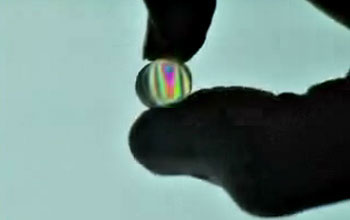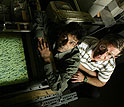|

Press Release 05-105
The Shifty Nature of Grains

Qualities of granular materials provide insight into both nature and industry
June 22, 2005
In separate papers appearing in this week's Nature, researchers announce findings regarding the little-understood world of granular materials, systems of particles that can dictate the flow of avalanches, the quality of concrete and even the mixing of pharmaceuticals.
In both studies, the researchers developed new analytical tools that combine laboratory simulators with advanced computer simulations and mathematics, bringing additional quantitative methods to a field that relies mostly upon qualitative observations.
Duke University physics and engineering professor Robert Behringer and his graduate student, Trushant Majmudar, used a novel system that includes a bed of thousands of light-bending plastic cylinders to trace the flow of stress, particle by particle, in a 2-dimensional granular set up. The researchers found that stresses applied to one dimension across the bed transferred along jagged pathways from one particle to the next when the other dimension was free from strain. However, when the system was compressed equally on both sides, the pathways, or "force chains," were much shorter.
The findings could prove important for understanding natural hazards such as the recent slope failures at La Conchita and Laguna Beach in California. Strongly shear states with long force chains occur just before the granular material fails, similar to the collapsing sandy cliffs.
The second report comes from the Chicago Materials Research Center at the University of Chicago, one of nearly 30 NSF-supported Materials Research Science and Engineering Center. Physicists Heinrich Jaeger and Sidney Nagel worked with graduate student Eric Corwin to develop a different testing system, in this case comprised of a cylinder filled with up to 100,000 glass beads compressed over hour-long periods by a rotating piston. Their goal was to study shear forces in granular materials.
The Chicago researchers were able to quantify a characteristic change in the way stresses propagate through the materials when the grains shift from a jammed state to a flowing one. The researchers suspect the underlying mechanism, whereby grains acquire an "effective temperature" in their flowing state, has wide-reaching implications for better understanding materials that are jammed at the atomic level, such as glass.
Glass behaves like a solid but can flow like a liquid, particularly at higher temperatures. If the granular studies hold true, this project may have resolved decades-old questions regarding the transition of solids into the more fluid glass-like state.
-NSF-
The Duke University press release can be found at: http://www.dukenews.duke.edu/2005/06/stressmeasure
The University of Chicago press release can be found at: http://www-news.uchicago.edu/releases/05/050622.jamming.shtml
The Duke University research was funded by NSF Award #0137119:
Force Propagation and Friction in Granular Materials
http://www.nsf.gov/awardsearch/showAward.do?AwardNumber=0137119
The University of Chicago research was funded under NSF Awards #0213745 and #0405619:
Materials Research Science and Engineering Center
http://www.nsf.gov/awardsearch/showAward.do?AwardNumber=0213745 Experimental Investigations of Sheared Granular Materials
http://www.nsf.gov/awardsearch/showAward.do?AwardNumber=0405619

Media Contacts
Joshua A. Chamot, NSF (703) 292-8070 jchamot@nsf.gov
Monte Basgall, Duke University (919) 681-8057 monte.basgall@duke.edu
Steve Koppes, University of Chicago (773) 702-8366 skoppes@uchicago.edu
Program Contacts
Thomas P. Rieker, NSF (703) 292-4914 trieker@nsf.gov
Wendy Fuller-Mora, NSF (703) 292-4931 wfullerm@nsf.gov
Triantafillos J. Mountziaris, NSF (703) 292-8371 tmountzi@nsf.gov
Co-Investigators
Bob Behringer, Duke University (919) 660-2550 bob@phy.duke.edu
Sidney R. Nagel, University of Chicago (773) 702-7190 s-nagel@uchicago.edu
Heinrich M. Jaeger, University of Chicago (773) 702-6074 h-jaeger@uchicago.edu

The National Science Foundation (NSF) is an independent federal agency that
supports fundamental research and education across all fields of science and
engineering, with an annual budget of $6.06 billion. NSF funds reach all 50
states through grants to over 1,900 universities and institutions. Each year,
NSF receives about 45,000 competitive requests for funding, and makes over
11,500 new funding awards. NSF also awards over $400 million in
professional and service contracts yearly.
 Get News Updates by Email Get News Updates by Email
Useful NSF Web Sites:
NSF Home Page: http://www.nsf.gov
NSF News: http://www.nsf.gov/news/
For the News Media: http://www.nsf.gov/news/newsroom.jsp
Science and Engineering Statistics: http://www.nsf.gov/statistics/
Awards Searches: http://www.nsf.gov/awardsearch/
| 




